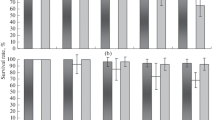Abstract
Estimates of daily fecundity, hatching success and fecal pellet production are reported for Acartia clausi females exposed for 10 d to low levels of phenol and ammonia. Copepods were collected in 1991 and 1992 from a southern coastal area of the Mar Grande of Taranto (southern Italy). A reduction in egg numbers and fecal pellet production was observed for females after 8 d of exposure to 500 μg l-1 phenol concentration. Ammonia (120 μg l-1) produced a significant increment in egg production, but hatching success was reduced by about 50% after nine exposure days. A. clausi was more sensitive to ammonia than phenol at high concentrations (24-h LC50 phenol-32.26 mg l-1; 24-h LC50 ammonia=0.91 mg l-1). At low concentrations, only long-term exposure to phenol determined a reduction in fecundity.
Similar content being viewed by others
References
Airey D, Sandars G (1987) Automated analysis of nutrients in sea water. Rep CSIRO mar Lab 166: 1–106
Berdugo V, Harris RP, O'Hara SC (1977) The effect of petroleum hydrocarbons on reproduction of an estuarine planktonic copepod in laboratory cultures. Mar Pollut Bull 8 (6): 138–143
Buttino I, Filippi M, Cardellicchio N (1991) Tossicità dei composti fenolici nell'ambiente marino. Acqua Aria 9: 853–861
Corner EDS (1978) Pollution studies with marine plankton. Part I. Petroleum hydrocarbons and related compounds. Adv mar Biol 15: 289–380
Cowles TJ, Remillard JF (1983) Effects of exposure to sublethal concentrations of crude oil on the copepod Centropages hamatus. I. Feeding and egg production. Mar Biol 78: 45–51
Harris RP, Berdugo V, O'Hara SCM, Corner EDS (1977) Accumulation of 14C-1-naphthalene by an oceanic and an estuarine copepod during long-term exposure to low-level concentrations. Mar Biol 42: 187–195
Ianora A, Buttino I (1990) Seasonal cycles in population abundances and egg production rates in the planktonic copepods Acartia clausi and Centropages typicus. J Plankton Res 12 (3): 473–481
Kuiper J, Hanstveit AO (1984) Fate and effects of 4-chlorophenol and 2,4-dichlorophenol in marine plankton communities in experimental enclosure. Ecotoxicol Envir Saf 8: 15–33
Linden E, Bengtsson BE, Svanberg O, Sundstrom G (1979) The acute toxicity fo 78 chemicals and pesticide formulations against two brackish water organisms, the bleak (Alburnus alburnus) and the harpacticoid (Nicotra spinipes). Chemosphere 11 (12): 843–851
Litchfield JT Jr, Wilcoxon F (1949) A simplified method of evaluating dose-effect experiments. J Pharmac exper Ther 96: 99–113
Moraitou-Apostolopoulou M, Verriopoulos G (1981) Egg viability in two populations of Acartia clausi exposed to different degrees of pollution. Vie Milieu 31 (1): 65–69
O'Brien WJ, Kettle D (1981) A zooplankton bioassay chamber for lab and field use. J Plankton Res 3 (4): 561–566
Puddu A (1989) Programma di calcolo per l'elaborazione dei risultati di un saggio di tossicità mediante analisi dei probits. C.N.R. Istituto di Ricerca sulle Acque. Metodi Analitici Acque, Notiziario 9 (2): 19–37
Schauerte W, Lay JP, Klein W, Korte F (1982) Influence of 2,4,6-trichlorophenol and pentachlorophenol on the biota of aquatic systems. Chemosphère 11 (1): 71–79
Spooner MF, Corkett CJ (1974) A method for testing the toxicity of suspended oil droplets on planktonic copepods used at Plymouth. In: Beynon LR, Cowell EB (eds) Ecological aspects of toxicity testing of oils and dispersants. Applied Science Publishers, Barking, Essex, pp 69–74
Spooner MF, Corkett CJ (1979) Effects of Kuwait oilson feeding rates of copepods. Mar Pollut Bull 10: 197–202
Steinberg PD (1988) Effects of quantiative variation in phenolic compounds on feeding in three species of marine invertebrate herbivores. J exp mar Biol Ecol 120: 221–237
Sullivan BK, Ritacco PJ (1985) Ammonia toxicity to larval copepods in eutrophic marine ecosystems: a comparison of results from bioassays and enclosed experimental ecosystems. Aquat Toxic 7: 205–217
US Environmental Protection Agency (1976) Bioassay procedures for the ocean disposal permit program. Environmental Research Laboratory Office of Research and Development. U.S.E.P.A. Gulf Breeze, Florida EPA 600/9-76-010
Venkataramiah A, Lakshmi G, Best C, Gunter G, Hartwig E, Wilde P (1982) Studies on toxicity of OTEC plant components on Eucalanus sp. from Gulf of Mexico. Ocean Sci Engng 7: 353–401
Wells PG (1984) Marine ecotoxicological tests with zooplankton. In: Persoone G, Jaspers E, Claus C (eds) Ecotoxicological testing for the marine environment. 1. State Univ. Ghent and Inst. Mar. Scien. Res., Breded, Belgium, pp 215–256
WHO (1986) Environmental health criteria for ammonia. World Health Organization. The International Programme on Chemical Safety (IPCS), 54, Vammala, Finland
Wyman KD, O'Connor HB Jr (1980) Implications of short-term PCB uptake by small estuarine copepods (genus Acartia) from PCB-contaminated water, inorganic sediments and phytoplankton. Estuar cstl mar Sci 11:121–131
Author information
Authors and Affiliations
Additional information
Communicated by M. Sarà, Genova
Rights and permissions
About this article
Cite this article
Buttino, I. The effect of low concentrations of phenol and ammonia on egg production rates, fecal pellet production and egg viability of the calanoid copepod Acartia clausi . Marine Biology 119, 629–634 (1994). https://doi.org/10.1007/BF00354327
Received:
Accepted:
Issue Date:
DOI: https://doi.org/10.1007/BF00354327



